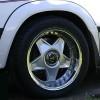| Author | Topic |
|---|

Location:
Castle Hill, Sydney
Registered:
February 2004
|
|
boosting high comp
|
 Sun, 18 July 2004 09:38
Sun, 18 July 2004 09:38

|
 |
just wondering why all boosted engines are low comp high boost?
will high comp, low boost be just as effective?
|
|
|

I supported Toymods
Location:
Plumpton/sydney
Registered:
November 2003
|
|
Re: boosting high comp
|
 Sun, 18 July 2004 11:40
Sun, 18 July 2004 11:40
 
|
 |
|
my mate has a blown chev 350 and it runs 11.5:1 comp and the blower pumps 35psi boost the idea is that there is no room for the motor to detinate so it doesnt blow up there is to much fuel and no air so there is less chance of it blowing up
|
|
|

Location:
Castle Hill, Sydney
Registered:
February 2004
|
|
|

Location:
Newcastle NSW
Registered:
June 2002
|
|
Re: boosting high comp
|
 Sun, 18 July 2004 12:14
Sun, 18 July 2004 12:14
 
|
 |
the newer boosted engines are using higher compression than the old ones. 4agze uses a 8.9:1 which is not really high but is still better than many NA engines.
the main reason for this is off boost response being better on high comp i know saab recently had a high compression turbo Viggen that was apparently running 5-6 psi on a cr of around 10:1
u will need very good tuning to pull it off and a constant supply of good fuel.
|
|
|

Location:
Brisbane
Registered:
May 2002
|
|
Re: boosting high comp
|
 Sun, 18 July 2004 13:04
Sun, 18 July 2004 13:04
 
|
 |
Boost means higher cylinder pressures, and higher cylinder pressure means harmful detonation is far more likely to occur. There are many ways to counteract this, but reducing the compression ratio is the simplest way from a mass production perspective. As mentioned above things are improving; early turbo engines ran very low compression (7.0:1 or thereabouts was the norm in the early 80's) but most turbo engines these days are above 9.0:1. This is mostly because of improvements in cylinder head design and engine management technology.
As for the 350 Chev with 11.5:1 and 35psi, I'm not sure where you got this idea about there being "no room" for detonation (whatever that means), but the only way those figures are possible is if it's running methanol, which is far more resistant to detonation than petrol. There's no way a petrol engine will hold together with that sort of compression and boost.
|
|
|

Location:
Melbourne
Registered:
August 2003
|
|
Re: boosting high comp
|
 Mon, 19 July 2004 05:32
Mon, 19 July 2004 05:32
 
|
 |
All else equal...
- A high compression NA motor can approach 100% VE but never achieve it.
- A high static compression low boost FI motor can exceed 100% VE by a bit.
- A low static compression high boost FI motor can exceed 100% VE by heaps.
Think about it.
|
|
|

Location:
Castle Hill, Sydney
Registered:
February 2004
|
|
|
Location:
brisbane
Registered:
September 2004
|
|
Re: boosting high comp
|
 Sun, 12 September 2004 10:14
Sun, 12 September 2004 10:14
 
|
 |
| SeptemberSquallIndustries wrote on Mon, 19 July 2004 15:32 |
All else equal...
- A high compression NA motor can approach 100% VE but never achieve it.
- A high static compression low boost FI motor can exceed 100% VE by a bit.
- A low static compression high boost FI motor can exceed 100% VE by heaps.
Think about it.
|
NA motors can acheive 100% VE, and exceed it.
|
|
|

Location:
Melbourne
Registered:
August 2003
|
|
Re: boosting high comp
|
 Sun, 12 September 2004 10:39
Sun, 12 September 2004 10:39
 
|
 |
|
Okay, in some cases perhaps. The vast majority of regular NA engines cannot surpass 100%VE. For the sake of illustration my example stands until you can prove it is fundamentally flawed, not just nitpick!
|
|
|

Location:
Kita-Ku, Sapporo, Japan
Registered:
January 2003
|
|
Re: boosting high comp
|
 Sun, 12 September 2004 10:47
Sun, 12 September 2004 10:47
 
|
 |
to exceed 100% you need revs.. and lots of them... more than almost all car engines can produce... think ferrari, F1, CBR250 etc...
how much boost will entiorely depend on your tuning and combustion chamber design.
you can use fuel to drown out "pre-ignition", but pinging is from timing being too advanced.. ppl too often refer to them both as 'pinging'...
Cya, Stewart
|
|
|

Location:
Melbourne
Registered:
May 2002
|
|
Re: boosting high comp
|
 Sun, 12 September 2004 10:54
Sun, 12 September 2004 10:54
 
|
 |
| SeptemberSquallIndustries wrote on Mon, 19 July 2004 15:32 |
All else equal...
- A high compression NA motor can approach 100% VE but never achieve it.
- A high static compression low boost FI motor can exceed 100% VE by a bit.
- A low static compression high boost FI motor can exceed 100% VE by heaps.
Think about it.
|
but a low static comp engine will only have greater then 100%ve for a short amount of time up high in its rev range.. a mid comp mid boost engine will be at its peek efficiency for longer and lower in the the rev range
|
|
|
Location:
Adelaide
Registered:
June 2002
|
|
Re: boosting high comp
|
 Mon, 13 September 2004 00:12
Mon, 13 September 2004 00:12
 
|
 |
In response to your question, 10.5:1 is probably starting to push your luck a bit. One of the factors that influences how high you can go in the static comp is the combustion chamber design. As a general rule of thumb, the younger design the engine, the more comp you'll get away with.
A couple other things to consider-
Keep the incoming boost nice and cold-ie a BIG i/c.
Smooth the combustion chambers to eliminate any hot spots.
You may get away with it-but it will require premium or better, and some good plugs.
Alternately, attack the chambers with a grinder and pull 0.5-1.0 compression points out of it that way.
Sean
|
|
|
Location:
Sydney
Registered:
September 2004
|
|
Re: boosting high comp
|
 Mon, 13 September 2004 03:27
Mon, 13 September 2004 03:27

|
 |
The other main factor to take into consideration is cam profile. Big duration cams reduce the effective compression somewhat so that big static compression ratios can be run. The problem then becomes low rpm response is reduced.
I'd be looking to make the compression about 9.5-9.8:1.
|
|
|